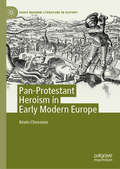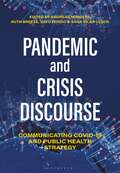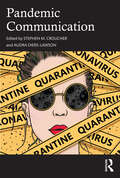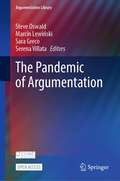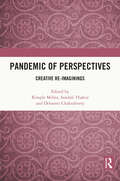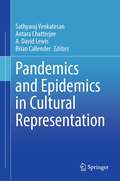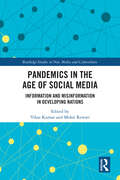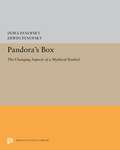- Table View
- List View
Pamuk's Istanbul: The Self and the City
by Pallavi NarayanThis book reconstructs Istanbul through the prism of Orhan Pamuk’s fiction. It navigates the multiple selves and layers of Istanbul to present how the city has shaped the writings of Pamuk and has, in turn, been shaped by it. Through everyday objects and architecture, it shows how Pamuk transforms the city into a living museum where different objects converse along with characters to present a rich tapestry across space and time. Further, the monograph explores the formation of communal and literary identity within and around nation-building narratives informed by capitalism and modernization. The book also examines how Pamuk uses the postmodern city to move beyond its postmodern confines, and utilizes the theories and universes of Bakhtin, Benjamin, and Foucault to open up his fiction and radically challenge the idea of the novel. The volume will be of great interest to scholars and researchers of literature, literary theory, museum studies, architecture, and cultural studies, and especially appeal to readers of Orhan Pamuk.
Pan (Oxford World's Classics)
by Knut Hamsun'When the snow water had broken crevices open in the mountain a shot or even just a sharp cry was enough to tear loose a huge slab and send it toppling.' Lieutenant Thomas Glahn spends a summer in northern Norway, where the midnight sun triggers a short but intense release of energies. Living out of a rudimentary hut on the edge of the forest, he pursues a solitary existence, hunting, fishing, and engaging intermittently with the inhabitants of the nearby coastal village. Among these is Edvarda, daughter of the wealthy local trader Herr Mack. Their mutual attraction rapidly develops into an erotic fascination shot through with suspicions and jealousies; a series of fraught encounters culminates in violent actions with unforeseen consequences. First published in 1894, Pan was an immediate success and remains a classic of Norwegian literature. It embodies many of the distinctive features of Hamsun's early works, in particular a rejection of psychological stereotypes and a style infused by what Hamsun called a 'poetry of the nerves'. Terence Cave's new translation restores the power and virtuosity of Hamsun's original and includes an illuminating introduction and explanatory notes. ABOUT THE SERIES: For over 100 years Oxford World's Classics has made available the widest range of literature from around the globe. Each affordable volume reflects Oxford's commitment to scholarship, providing the most accurate text plus a wealth of other valuable features, including expert introductions by leading authorities, helpful notes to clarify the text, up-to-date bibliographies for further study, and much more.
Pan (Oxford World's Classics)
by Knut Hamsun'When the snow water had broken crevices open in the mountain a shot or even just a sharp cry was enough to tear loose a huge slab and send it toppling.' Lieutenant Thomas Glahn spends a summer in northern Norway, where the midnight sun triggers a short but intense release of energies. Living out of a rudimentary hut on the edge of the forest, he pursues a solitary existence, hunting, fishing, and engaging intermittently with the inhabitants of the nearby coastal village. Among these is Edvarda, daughter of the wealthy local trader Herr Mack. Their mutual attraction rapidly develops into an erotic fascination shot through with suspicions and jealousies; a series of fraught encounters culminates in violent actions with unforeseen consequences. First published in 1894, Pan was an immediate success and remains a classic of Norwegian literature. It embodies many of the distinctive features of Hamsun's early works, in particular a rejection of psychological stereotypes and a style infused by what Hamsun called a 'poetry of the nerves'. Terence Cave's new translation restores the power and virtuosity of Hamsun's original and includes an illuminating introduction and explanatory notes. ABOUT THE SERIES: For over 100 years Oxford World's Classics has made available the widest range of literature from around the globe. Each affordable volume reflects Oxford's commitment to scholarship, providing the most accurate text plus a wealth of other valuable features, including expert introductions by leading authorities, helpful notes to clarify the text, up-to-date bibliographies for further study, and much more.
Pan-Protestant Heroism in Early Modern Europe (Early Modern Literature in History)
by Kevin ChovanecThis book offers the first full study of the challenges posed to an emerging English nationalism that stemmed from the powerful appeal exerted by the leaders of the international Protestant cause. By considering a range of texts, including poetry, plays, pamphlets, and religious writing, the study reads this heroic tradition as a 'connected literary history,' a project shared by Protestants throughout Northern Europe, which opened up both collaboration among writers from these different regions and new possibilities for communal identification. The work’s central claim is that a pan-Protestant literary field existed in the period, which was multilingual, transnational, and ideologically charged. Celebrated leaders such as William of Orange posed a series of questions, especially for English Protestants, over the relationship between English and Protestant identity. In formulating their role as co-religionists, writers often undercut notions of alterity, rendering early modern conceptions of foreignness especially fluid and erasing national borders.
The Panchatantra: Translated from the Sanskrit (Routledge Revivals)
by Franklin EdgertonFirst Published in 1965, The Panchatantra is a reprint of Franklin Edgerton’s translation, first published in volume two of Panchatantra Reconstructed (1924), with some minor alterations. Probably no other work of Hindu literature has played so important a part in the literature of the world as the Sanskrit story collection called the Panchatantra. The title means ‘the five books’, and most of the older versions and translations keep this division, although the last two books are much shorter than the first three. All the ‘books’ contain at least one story, and usually more, which are ‘emboxed’ in the main story, called the ‘frame-story’. The original Sanskrit text is composed in a mixture of prose and stanzas of verse. The stories proper are told almost wholly in prose. This translation work is an important book for scholars and students of South Asian literature and Sanskrit studies.
The Panchatantra: Translated from the Sanskrit (Routledge Revivals)
by Franklin EdgertonFirst Published in 1965, The Panchatantra is a reprint of Franklin Edgerton’s translation, first published in volume two of Panchatantra Reconstructed (1924), with some minor alterations. Probably no other work of Hindu literature has played so important a part in the literature of the world as the Sanskrit story collection called the Panchatantra. The title means ‘the five books’, and most of the older versions and translations keep this division, although the last two books are much shorter than the first three. All the ‘books’ contain at least one story, and usually more, which are ‘emboxed’ in the main story, called the ‘frame-story’. The original Sanskrit text is composed in a mixture of prose and stanzas of verse. The stories proper are told almost wholly in prose. This translation work is an important book for scholars and students of South Asian literature and Sanskrit studies.
Pandemic and Crisis Discourse: Communicating COVID-19 and Public Health Strategy
by Andreas Musolff, Ruth Breeze, Kayo Kondo and Sara Vilar-LluchThe COVID-19 pandemic has led to a host of critical reflections about discourse practises dealing with public health issues. Situating crisis communication at the centre of societal and political debates about responses to the pandemic, this volume analyses the discursive strategies used in a variety of settings. Exploring how crisis discourse has become a part of managing the public health crisis itself, this book focuses on the communicative tasks and challenges for both speakers and their public audiences in seven areas:- establishment of discursive and political authority - official governmental and expert communication to the public - public understanding of government communication- legitimation of public health management as a 'war' - judging and blaming a collective other- cross-national comparison and rivalry - empathy and encouragementCovering global discourses from Asia, Europe, the Middle East, North and South America, and New Zealand, chapters use corpus-based data to cast light on these issues from a variety of languages. With crisis discourse already the object of fierce national and international debates about the appropriateness of specific communicative styles, information management and 'verbal hygiene', Pandemic and Crisis Discourse offers an authoritative intervention from language experts.
Pandemic and Crisis Discourse: Communicating COVID-19 and Public Health Strategy
The COVID-19 pandemic has led to a host of critical reflections about discourse practises dealing with public health issues. Situating crisis communication at the centre of societal and political debates about responses to the pandemic, this volume analyses the discursive strategies used in a variety of settings. Exploring how crisis discourse has become a part of managing the public health crisis itself, this book focuses on the communicative tasks and challenges for both speakers and their public audiences in seven areas:- establishment of discursive and political authority - official governmental and expert communication to the public - public understanding of government communication- legitimation of public health management as a 'war' - judging and blaming a collective other- cross-national comparison and rivalry - empathy and encouragementCovering global discourses from Asia, Europe, the Middle East, North and South America, and New Zealand, chapters use corpus-based data to cast light on these issues from a variety of languages. With crisis discourse already the object of fierce national and international debates about the appropriateness of specific communicative styles, information management and 'verbal hygiene', Pandemic and Crisis Discourse offers an authoritative intervention from language experts.
Pandemic Communication
by Stephen M. Croucher Audra Diers-LawsonThis book details how the processes of communication are affected by the presence of a pandemic and establishes a research agenda for those effects across the broad field of communication studies. Through contributions from experts in communication subdisciplines such as crisis, organizational, interpersonal, health, intergroup, and intercultural, this book provides the reader with a comprehensive view of the emerging field of study "pandemic communication." Each chapter has four primary objectives to: (1) define critical issues for pandemic communication from its subdiscipline’s perspective, (2) examine how communication varies during pandemic(s), (3) provide examples of how pandemic(s) havefor affected communication, and (4) propose a research agenda to build pandemic communication theory. This book is suited to undergraduate or post-graduate courses or modules in communication studies across a variety of subdisciplines as well as a reference for researchers in the subject.
Pandemic Communication
by Stephen M. Croucher Audra Diers-LawsonThis book details how the processes of communication are affected by the presence of a pandemic and establishes a research agenda for those effects across the broad field of communication studies. Through contributions from experts in communication subdisciplines such as crisis, organizational, interpersonal, health, intergroup, and intercultural, this book provides the reader with a comprehensive view of the emerging field of study "pandemic communication." Each chapter has four primary objectives to: (1) define critical issues for pandemic communication from its subdiscipline’s perspective, (2) examine how communication varies during pandemic(s), (3) provide examples of how pandemic(s) havefor affected communication, and (4) propose a research agenda to build pandemic communication theory. This book is suited to undergraduate or post-graduate courses or modules in communication studies across a variety of subdisciplines as well as a reference for researchers in the subject.
Pandemic, Event, and the Immanence of Life: Critical Reflections on Covid-19
by Paul Patton Saima Saeed Ny ManojThis volume reflects on different regional and national experiences of the Covid 19 pandemic, with contributions from India, Thailand, Singapore, Australia, Italy, United States, and Canada.This book draws upon a number of approaches but especially the works of Deleuze and Guattari, Agamben, Derrida, Foucault, Habermas, Latour, and Serres. It looks at the methodological aspects of treating the pandemic, focuses on laying out the posthuman condition of the event largely problematizing the immanence of life which affirms the transversal Deleuzian ethic of life, and extends the politics of life to the domain of immunology. Together, the authors make it apparent that the pandemic is a multifaceted event, or many different kinds of events – virological, informational, phenomenological, social, and discursive. The authors skilfully develop these different dimensions of the pandemic event and show the relations between them. These essays will enrich the reader’s understanding of the pandemic and its effects, while demonstrating the depth and breadth of the resources that humanities scholarship can mobilize to help us understand such phenomena.This volume will be useful to students of posthumanism, medical humanities, health communication, political communication, semiotics, literature, cultural theories, and major strains of thought from contemporary continental philosophy.
Pandemic, Event, and the Immanence of Life: Critical Reflections on Covid-19
by Paul Patton Saima Saeed Manoj NyThis volume reflects on different regional and national experiences of the Covid 19 pandemic, with contributions from India, Thailand, Singapore, Australia, Italy, United States, and Canada.This book draws upon a number of approaches but especially the works of Deleuze and Guattari, Agamben, Derrida, Foucault, Habermas, Latour, and Serres. It looks at the methodological aspects of treating the pandemic, focuses on laying out the posthuman condition of the event largely problematizing the immanence of life which affirms the transversal Deleuzian ethic of life, and extends the politics of life to the domain of immunology. Together, the authors make it apparent that the pandemic is a multifaceted event, or many different kinds of events – virological, informational, phenomenological, social, and discursive. The authors skilfully develop these different dimensions of the pandemic event and show the relations between them. These essays will enrich the reader’s understanding of the pandemic and its effects, while demonstrating the depth and breadth of the resources that humanities scholarship can mobilize to help us understand such phenomena.This volume will be useful to students of posthumanism, medical humanities, health communication, political communication, semiotics, literature, cultural theories, and major strains of thought from contemporary continental philosophy.
Pandemic Health and Fitness (Routledge Studies in Health Humanities)
by Sabina M. Perrino Joshua O. RenoThis book adopts an innovative approach in exploring the evolution of fitness practices among a community of gym goers amid a global pandemic, considering its impact on the interplay of the words, habits, and relationships gym goers use in realizing their aspirations of wellness and well-being.Perrino and Reno introduce a multilayered framework which combines insights from linguistic and sociocultural anthropology, integrating narrative analysis, discourse analysis, and ethnography, with autoethnography. This approach allows for a holistic portrait of the gym as a research site and of fitness as a fruitful area for dynamic cross-disciplinary study. The volume explores how the COVID-19 pandemic has shaped attitudes and practices around fitness, drawing on audio and video recordings and the authors’ lived experiences to analyze everything from workout choreography to micro-celebrity fitness culture to group classes. The book raises key questions around what it means to be well amid a pandemic, the practical dangers of realizing fitness goals in such times, the effects on the social relationships inherent to gym culture, and the impact on identity construction and self-reflection.This volume will appeal to scholars interested in the interdisciplinary study of fitness, in such areas as linguistic anthropology, sociocultural anthropology, health humanities, and sport studies.
Pandemic Health and Fitness (Routledge Studies in Health Humanities)
by Sabina M. Perrino Joshua O. RenoThis book adopts an innovative approach in exploring the evolution of fitness practices among a community of gym goers amid a global pandemic, considering its impact on the interplay of the words, habits, and relationships gym goers use in realizing their aspirations of wellness and well-being.Perrino and Reno introduce a multilayered framework which combines insights from linguistic and sociocultural anthropology, integrating narrative analysis, discourse analysis, and ethnography, with autoethnography. This approach allows for a holistic portrait of the gym as a research site and of fitness as a fruitful area for dynamic cross-disciplinary study. The volume explores how the COVID-19 pandemic has shaped attitudes and practices around fitness, drawing on audio and video recordings and the authors’ lived experiences to analyze everything from workout choreography to micro-celebrity fitness culture to group classes. The book raises key questions around what it means to be well amid a pandemic, the practical dangers of realizing fitness goals in such times, the effects on the social relationships inherent to gym culture, and the impact on identity construction and self-reflection.This volume will appeal to scholars interested in the interdisciplinary study of fitness, in such areas as linguistic anthropology, sociocultural anthropology, health humanities, and sport studies.
The Pandemic of Argumentation (Argumentation Library #43)
by Serena Villata Steve Oswald Sara Greco Marcin LewińskiThis open access book addresses communicative aspects of the current COVID-19 pandemic as well as the epidemic of misinformation from the perspective of argumentation theory. Argumentation theory is uniquely placed to understand and account for the challenges of public reason as expressed through argumentative discourse. The book thus focuses on the extent to which the forms, norms and functions of public argumentation have changed in the face of the COVID-19 pandemic. This question is investigated along the three main research lines of the COST Action project CA 17132: European network for Argumentation and Public PoLicY analysis (APPLY): descriptive, normative, and prescriptive. The volume offers a broad range of contributions which treat argumentative phenomena that are directly related to the changes in public discourse in the wake of the outburst of COVID-19. The volume additionally places particular emphasis on expert argumentation, given (i) the importance expert discourse has had over the last two years, and (ii) the challenges that expert argumentation has faced in the public sphere as a result of scientific uncertainty and widespread misinformation. Contributions are divided into three groups, which (i) examine various features and aspects of public and institutional discourse about the COVID-19 pandemic, (ii) scrutinize the way health policies have been discussed, debated, attacked and defended in the public sphere, and (iii) consider a range of proposals meant to improve the quality of public discourse, and public deliberation in particular, in such a way that concrete proposals for argumentative literacy will be brought to light. Overall, this volume constitutes a timely inquiry into all things argumentative in pandemic discourse. This volume is of interest to a broad readership including philosophers, linguists, communication and legal scholars, and members of the wider public who seek to better understand the discourse surrounding communicative phenomena in times of crisis.COST (European Cooperation in Science and Technology) is a funding organisation for research and innovation networks. For more information: www.cost.eu
Pandemic of Perspectives: Creative Re-imaginings
by Rimple Mehta Sandali Thakur Debaroti ChakrabortyThis volume brings together academics, activists, social work practitioners, poets, and artists from different parts of the world during the Covid-19 pandemic. It sheds light on how the pandemic has exposed the inequities in society and is shaping social institutions, affecting human relationships, and creating new norms with each passing day. It examines how people from diverse societies and fields of work have come to conceptualise and imagine a new world order based on the principles of social and ecological justice, care, and human dignity. It prioritises the realm of imagination, creativity, and affect in understanding social formations and in shaping societies beyond the positivist approaches. Documenting the myriad experiences and responses to the pandemic, the volume foregrounds varied processes of making meaning; understanding impulses, resistances, and coping mechanisms; and building solidarities. Further, it also acts as a tool of memory for future generations, and articulations- artistic, political, socio-cultural, scientific- of hope and perseverance. This spectrum of expressions intends to value visceral experiences, build solidarities, and find solace in art. Its uniqueness lies in the way it brings together a much-needed interface between science, social sciences, and humanities. A compelling account on our contemporary lives, the volume will be of great interest to scholars of sociology and social anthropology, politics, art and aesthetics, psychology, social work, literature, health, and medical sciences.
Pandemic of Perspectives: Creative Re-imaginings
by Rimple Mehta Sandali Thakur Debaroti ChakrabortyThis volume brings together academics, activists, social work practitioners, poets, and artists from different parts of the world during the Covid-19 pandemic. It sheds light on how the pandemic has exposed the inequities in society and is shaping social institutions, affecting human relationships, and creating new norms with each passing day. It examines how people from diverse societies and fields of work have come to conceptualise and imagine a new world order based on the principles of social and ecological justice, care, and human dignity. It prioritises the realm of imagination, creativity, and affect in understanding social formations and in shaping societies beyond the positivist approaches. Documenting the myriad experiences and responses to the pandemic, the volume foregrounds varied processes of making meaning; understanding impulses, resistances, and coping mechanisms; and building solidarities. Further, it also acts as a tool of memory for future generations, and articulations- artistic, political, socio-cultural, scientific- of hope and perseverance. This spectrum of expressions intends to value visceral experiences, build solidarities, and find solace in art. Its uniqueness lies in the way it brings together a much-needed interface between science, social sciences, and humanities. A compelling account on our contemporary lives, the volume will be of great interest to scholars of sociology and social anthropology, politics, art and aesthetics, psychology, social work, literature, health, and medical sciences.
Pandemics and Epidemics in Cultural Representation
by Sathyaraj Venkatesan Antara Chatterjee A. David Lewis Brian CallenderThis edited book analyses how artists, authors, and cultural practitioners have responded to and represented episodes of epidemics/pandemics through history. Covering a broad range of notable epidemics/pandemics (black death, cholera, Influenza, AIDS, Ebola, COVID-19), the chapters examine the cultural representations of epidemics and pandemics in different contexts, periods, languages, media, and genres. Interdisciplinary in nature and drawing on perspectives from medicine, literature, medical anthropology, philosophy of medicine, and cultural theory, the book investigates and emphasizes the urgent need to reflect on past catastrophes caused by such outbreaks. By delving into cultural history, it re-examines how societies and communities have responded in the past to species-threatening epidemics/pandemics. Sure to be of interest to lay readers as well as students and researchers, this work situates epidemics and pandemics outbreaks within the contexts of culture and narrative, and their complex and layered representation, commenting on intersections of contagion, culture, and community. It offers a cross-cultural, global, and comparative analysis of the trajectories, histories and responses to various epidemics/pandemics that impacted people worldwide.
Pandemics in the Age of Social Media: Information and Misinformation in Developing Nations (Routledge Studies in New Media and Cyberculture)
by Vikas Kumar Mohit RewariThis book offers insights into social media practices and challenges in developing nations during the COVID-19 pandemic. Covering different aspects of social media during the pandemic, the book offers new frameworks, concepts, tools and techniques for integrating social media to support national development. Thematically organized chapters from a global team of scholars address the different aspects of social media during the pandemic. The book begins by looking at ICT for development and how development agencies have used social media platforms, before looking at engagement with these social media campaigns and the spread of misinformation. Further chapters cover the practical uses of social media in healthcare and virtual medicine, mental health issues and challenges, remote education and government policies. This timely volume will be of interest to scholars and students of social media, health communication, global development studies and NGO communication.
Pandemics in the Age of Social Media: Information and Misinformation in Developing Nations (Routledge Studies in New Media and Cyberculture)
by Vikas Kumar Mohit RewariThis book offers insights into social media practices and challenges in developing nations during the COVID-19 pandemic. Covering different aspects of social media during the pandemic, the book offers new frameworks, concepts, tools and techniques for integrating social media to support national development. Thematically organized chapters from a global team of scholars address the different aspects of social media during the pandemic. The book begins by looking at ICT for development and how development agencies have used social media platforms, before looking at engagement with these social media campaigns and the spread of misinformation. Further chapters cover the practical uses of social media in healthcare and virtual medicine, mental health issues and challenges, remote education and government policies. This timely volume will be of interest to scholars and students of social media, health communication, global development studies and NGO communication.
Pandora's Box: The Changing Aspects of a Mythical Symbol (Princeton Legacy Library #5384)
by Dora Panofsky Erwin PanofskyPandora waas the "pagan Eve," and she is one of the rare mythological figures to have retained vitality up to our day. Glorified by Calderon, Voltaire, and Goethe, she is familiar to all of us, and "Pandora's box" is a household word. In this classic study Dora and Erwin Panofsky trace the history of Pandora and of Pandora's box in European literature and art from Roman times to the present.Originally published in 1962.The Princeton Legacy Library uses the latest print-on-demand technology to again make available previously out-of-print books from the distinguished backlist of Princeton University Press. These editions preserve the original texts of these important books while presenting them in durable paperback and hardcover editions. The goal of the Princeton Legacy Library is to vastly increase access to the rich scholarly heritage found in the thousands of books published by Princeton University Press since its founding in 1905.
Pandora's Box: The Changing Aspects of a Mythical Symbol (Princeton Legacy Library #5384)
by Dora Panofsky Erwin PanofskyPandora waas the "pagan Eve," and she is one of the rare mythological figures to have retained vitality up to our day. Glorified by Calderon, Voltaire, and Goethe, she is familiar to all of us, and "Pandora's box" is a household word. In this classic study Dora and Erwin Panofsky trace the history of Pandora and of Pandora's box in European literature and art from Roman times to the present.Originally published in 1962.The Princeton Legacy Library uses the latest print-on-demand technology to again make available previously out-of-print books from the distinguished backlist of Princeton University Press. These editions preserve the original texts of these important books while presenting them in durable paperback and hardcover editions. The goal of the Princeton Legacy Library is to vastly increase access to the rich scholarly heritage found in the thousands of books published by Princeton University Press since its founding in 1905.
Pandora's Box: A Bloomsbury Reader (Bloomsbury Readers)
by Rose ImpeyA beautiful retelling of a classic Greek myth, perfect for fans of Geraldine McCaughrean.When the world was new and the gods ruled the whole of Earth, a large wooden chest was sent to a newly-married couple with a warning not to open it. The chest was hidden away with the thought 'out of sight, out of mind'. But curiosity is a powerful thing and it can't hurt to have one little look... can it?This retelling of the classic Greek myth from Rose Impey has engaging black-and-white illustrations by Peter Bailey and is perfect for children who are developing as readers.The Bloomsbury Readers series is packed with brilliant books to get children reading independently in Key Stage 2, with book-banded stories by award-winning authors like double Carnegie Medal winner Geraldine McCaughrean and Waterstones Prize winner Patrice Lawrence covering a wide range of genres and topics. With charming illustrations and online guided reading notes by the Centre for Literacy in Primary Education (CLPE), this series is ideal for reading both in the classroom and at home. For more information visit www.bloomsburyguidedreading.com.Book Band: BrownIdeal for ages 7+
Pandora's Box: A Bloomsbury Reader (Bloomsbury Readers)
by Rose ImpeyA beautiful retelling of a classic Greek myth, perfect for fans of Geraldine McCaughrean.When the world was new and the gods ruled the whole of Earth, a large wooden chest was sent to a newly-married couple with a warning not to open it. The chest was hidden away with the thought 'out of sight, out of mind'. But curiosity is a powerful thing and it can't hurt to have one little look... can it?This retelling of the classic Greek myth from Rose Impey has engaging black-and-white illustrations by Peter Bailey and is perfect for children who are developing as readers.The Bloomsbury Readers series is packed with brilliant books to get children reading independently in Key Stage 2, with book-banded stories by award-winning authors like double Carnegie Medal winner Geraldine McCaughrean and Waterstones Prize winner Patrice Lawrence covering a wide range of genres and topics. With charming illustrations and online guided reading notes by the Centre for Literacy in Primary Education (CLPE), this series is ideal for reading both in the classroom and at home. For more information visit www.bloomsburyguidedreading.com.Book Band: BrownIdeal for ages 7+
Pandora's Jar: Women in the Greek Myths
by Natalie Haynes'Natalie Haynes is the nation's muse' Adam RutherfordThe Greek myths are among the world's most important cultural building blocks and they have been retold many times, but rarely do they focus on the remarkable women at the heart of these ancient stories.Stories of gods and monsters are the mainstay of epic poetry and Greek tragedy, from Homer to Aeschylus, Sophocles and Euripides, from the Trojan War to Jason and the Argonauts. And still, today, a wealth of novels, plays and films draw their inspiration from stories first told almost three thousand years ago. But modern tellers of Greek myth have usually been men, and have routinely shown little interest in telling women’s stories. And when they do, those women are often painted as monstrous, vengeful or just plain evil. But Pandora – the first woman, who according to legend unloosed chaos upon the world – was not a villain, and even Medea and Phaedra have more nuanced stories than generations of retellings might indicate. Now, in Pandora’s Jar, Natalie Haynes – broadcaster, writer and passionate classicist – redresses this imbalance. Taking Pandora and her jar (the box came later) as the starting point, she puts the women of the Greek myths on equal footing with the menfolk. After millennia of stories telling of gods and men, be they Zeus or Agamemnon, Paris or Odysseus, Oedipus or Jason, the voices that sing from these pages are those of Hera, Athena and Artemis, and of Clytemnestra, Jocasta, Eurydice and Penelope.


